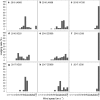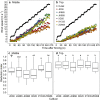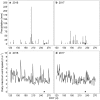In situ evaluation of stalk lodging resistance for different maize (Zea mays L.) cultivars using a mobile wind machine
- PMID: 31452672
- PMCID: PMC6701094
- DOI: 10.1186/s13007-019-0481-1
In situ evaluation of stalk lodging resistance for different maize (Zea mays L.) cultivars using a mobile wind machine
Abstract
Background: Stalk lodging is an impediment to improving profitability and production efficiency in maize. Lodging resistance, a comprehensive indicator to appraise genotypes, requires both characterization of mechanical properties in laboratory and investigation of lodging percentage in field. However, in situ characterization of maize lodging resistance still remains poor. The aim of this study was to develop an indicator, named cumulative lodging index (CLI), based on lodging percentages at different wind speeds for evaluating lodging resistance for different maize cultivars, and to evaluate the accuracy and reliability of this method.
Results: Different cultivars showed different patterns of lodging percentage along with wind speeds. The failure wind speed (FWS) for maize ranged between 16 and 30 m s-1 across cultivars. The CLI differed between maize cultivars and showed favorable reliability (i.e. nRMSE of 5.38%). Mechanical properties of the third internode did not vary significantly between cultivars. Significant differences in the reduction index (RI) of wind speed sheltered by maize canopy were found between cultivars.
Conclusion: Our findings implied that mobile wind machine is powerful in reproducing wind disaster that induce crop lodging. The newly-built CLI was demonstrated to be a more robust indicator than mechanical properties, FWS, and RI when evaluating lodging resistance in terms of both reliability and resolution. This study offers a new perspective for evaluating in situ lodging resistance of crops, and provides technical support for accurate identification of lodging-resistant phenotypic traits.
Keywords: Cumulative lodging index; Failure wind speed; Lodging resistance; Maize (Zea mays L.); Mechanical properties; Wind machine.
Conflict of interest statement
Competing interestsThe authors declare that they have no competing interests.
Figures









References
-
- Nielsen B. Stalk lodging in corn: guidelines for preventive management; 2006. https://www.extension.purdue.edu/extmedia/AY/AY-262.html. Assessed 10 Jan 2019.
-
- Gou L, Huang J, Rui S, Ding Z, Dong Z, Ming Z. Variation characteristic of stalk penetration strength of maize with different density-tolerance varieties. Trans CSAE. 2010;26:156–162.
-
- Cheng F, Du X, Liu M, Jin X, Cui Y. Lodging of summer maize and the effects on grain yield. J Maize Sci. 2011;19:105–108.
-
- Li S, Wang Y, Hu C, Yan Y. Effects of strong wind lodging at pre-and post-tasseling stages on growth and yield of summer maize. Chin J Appl Ecol. 2015;26(8):2405–2413. - PubMed
-
- Minami M, Ujihara A. Effects of lodging on dry matter production, grain yield and nutritional composition at different growth stages in maize (Zea mays L.) Jpn J Crop Sci. 1991;60(1):107–115. doi: 10.1626/jcs.60.107. - DOI
LinkOut - more resources
Full Text Sources
Research Materials
Miscellaneous

